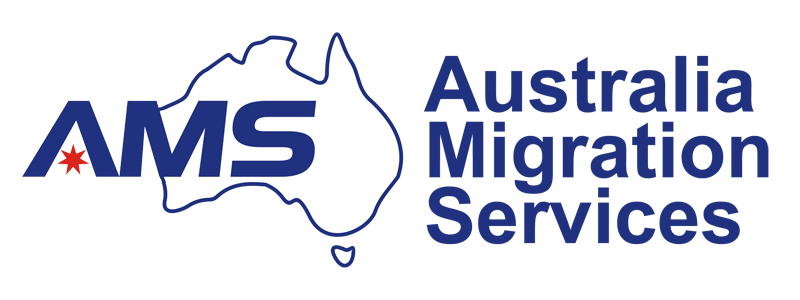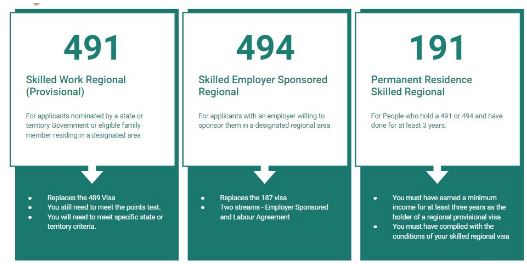On the 16th of November, two new types of skilled migrant visas will be open for application, the 494 and the 491.
According to official information, these two types of visas will replace the original visas, with the 491 replacing the 489 and the 494 replacing the 187 (RSMS) visa. The total quota for the two types of visas is 23,000 and the validity period is five years. As long as you have lived in a regional city in Australia for three years and met certain conditions (such as earning a minimum salary of $53,900 consecutively for three years), you can apply for a 191 visa (Permanent Residence Visa).
Requirements for the 491 visa (formerly 489 visa) include:
– The annual quota is 14,000
– The age limit is 45 years old
– Must live and work in a regional area for at least 3 years to switch to PR
– Meet pre-tax income of at least $53,900 for at least 3 years
– Holders can live in multiple regional areas
491 Point System
– Skilled English skill spouse (10 points)
– Spouse has English proficiency (5 points)
– Single applicant (10 points)
– Get a state or regional nomination (15 points)
– The applicant has a family member guaranteed to live in a remote area (15 points)
– Some STEM professional qualifications (research, masters or doctoral degrees, including Science, Technology, Engineering, and Mathematics)- must be an Australian degree/qualification with more than 2 years of schooling (10 points).
494 visa basic requirements:
– At least 3 years of full-time work experience and nominated occupation (except for special regulations)
– English reaches competent
– Effective career assessment (485 occupational assessment not applicable)
– Not more than 45 years old
191 Visa (Permanent Residence)
On November 16, 2019, the new regional permanent residence visa will officially be open for application.
Basic requirements for the 191 visa:
– The main application holds a 491 or 494 visa for at least 3 years.
– Living in a remote area for 3 years, and the income needs to meet the minimum tax return income specified by the USCIS
– Compliance with the terms of the residence visa
The similarities and differences between the 491 visa and the 489 visa (scoring immigration):
– State government guarantees points in remote areas changed from 10 points to 15 points
– Visa length increased from 4 years to 5 years
– New visa terms have been added, such as 8758 notify immigration of changes within 14 days to ensure the visa’s enforcement power
– Increased minimum income requirement, currently identified as pre-tax income of $53,900
– If New Skilled Regional Visas Bill 2019 is approved, 491 visa holders will receive PR-like benefits, while 489 will not.
– 489 visa holders are free to apply for other types of visas, while 491 visa holders, unless they have lived in Australia for 3 years, cannot apply for other skilled immigrant or business immigrant visas or get PR in advance
– Equivalent to getting a quasi-PR, the policy change after getting a visa will not affect the application for permanent residence (the quota, score and occupation list are no longer affected)
– You can still work and study in any remote area and no longer limited to the sponsoring state.
– Have the right to work during the 489/491 visa
The similarities and differences between the 494 visa and 187 visa (employer guarantee):
– The current 187 visa (direct stream) can lead to PR in one step, whereas the 494 is temporary residence and the overall immigration time will be longer.
– The new 494 visa requires three years of work for an employer in a regional area, and the applicant cannot apply for another skilled immigrant visa during the holding period. In other words, it is impossible to get a visa to a regional area and return to the metropolis within three years.
– The minimum income requirement needed to change to permanent residency is currently set at $53,900 for pre-tax income.
For the vast majority of applicants who plan to apply for a 491 or 494 visa, the ultimate goal is to meet the requirements and transfer to permanent residency. However, before you apply, you need to know the specific terms and the requirements for changing to permanent residency, in order to avoid detours and going ashore.
Several conditions for the transfer to 191 permanent residency visa after the expiration of 491 and 494:
– To submit a 191 visa, you must have a 491 or 494 visa for more than 3 years
– Applicants must strictly abide by Section 8579 (Residential Requirements) for temporary residence visas and basically abide by other terms. In other words, you cannot move back to the big city during the visa period!
– Three years of taxable income for five years is not less than the number specified by the Minister of Immigration ($53,900)
(This condition only requires the applicant to reside in a designated regional area in Australia and does not specify how much time to live in Australia. The 191 visa does not require additional residence time. It only requires a visa for 3 years which complies with the visa rules, and that the three-year tax revenue is sufficient).
In addition, 191 strictly adheres to condition 8579. If a person works in a big city in Australia for only one month, he/she may be denied a visa because he/she does not meet the conditions.
Another condition that many pay attention to is the income requirement of $53,900. The original text of the clause is as follows:
191.214
(1) The applicant has provided copies of notices of assessment, and any notices of amended assessments, given to the applicant under the Income Tax Assessment Act 1936 in relation to 3 relevant income years for the applicant.
(2) The applicant’s taxable income for each of those relevant income years is at least equal to the amount specified in an instrument under subclause (3) in relation to the applicant.
The applicant must provide a three-year Notice of Assessment, and the annual taxable income must be higher than the number specified by the Minister of Immigration (currently $53,900).
The difficulty of finding a job in a regional area is far greater than that of big cities such as Sydney and Melbourne. Many migrants will have to adapt to the local work culture,i.e. language barriers, etc and have to stand out from the fierce competition among local applicants.
For this reason, it is important that you:
-Understand the regional areas of Australia
-Understand the labour market in regional areas
-Understand workplace culture
-Understand the local employer and your two parties
-Understand immigration law and taxation





